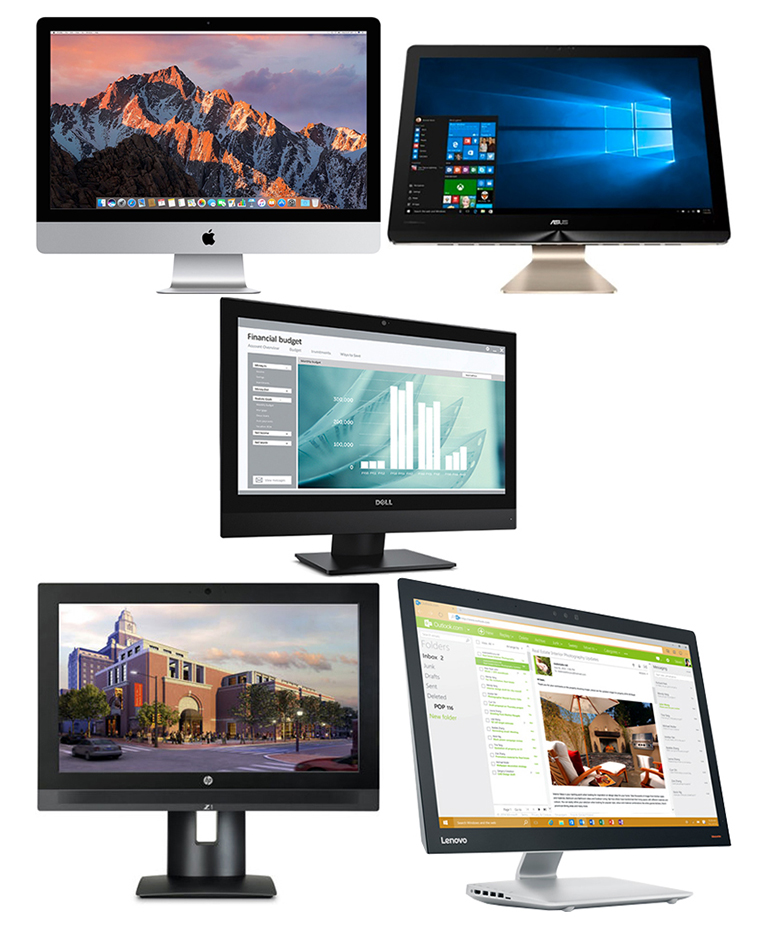Group Test: All-In-One desktop systems


The history of client devices is essentially one of increasing portability, as the tech industry's focus has progressively shifted from desktop PCs to laptops, tablets and smartphones (and most recently smartwatches and other wearables). Most people, in the developed world at least, now use multiple computing devices and form factors.
But legacy platforms rarely die off completely: instead, as they mature they settle into their core niches, which inevitably results in much lower shipments than were seen in their heyday. So it is with desktop PCs, which, despite having been pronounced 'dead' with tedious regularity in recent years, still have their place where a combination of screen real estate, computing horsepower and upgradability is required. Many designers, engineers, scientists, video and image editors, and knowledge workers, for example, still choose a desktop system as their primary computing platform.
Desktop PCs have, of course, themselves evolved -- from bulky towers to mini-towers, to small-form-factor PCs, to compact or mini PCs. Here we're examining the All-In-One (AIO) form factor, typified by Apple's iMac, in which the computing components are integrated into the monitor chassis. The advantage is a convenient small-footprint system, but the trade-off is usually limited scope for upgrades and repairs, along with the use of mobile-class components due to restricted chassis volume. In many businesses and homes, the choice will be between a transportable laptop with a large external monitor and a less transportable but potentially more powerful AIO system.
In this group test, we've gathered AIOs from the top five PC vendors worldwide -- Lenovo, HP, Dell, Apple and ASUS:
There's a spread of specifications and prices on view, ranging from Lenovo's £833 (ex. VAT) Core i5-based Ideacentre AIO 910 to HP's Xeon E3-based Z1 Workstation G3, which costs a hefty $3,486 (~£2,283 ex. VAT):
| Apple 27-inch iMac with Retina 5K Display | ASUS Zen AIO Pro Z240IC | Dell OptiPlex 7440 AIO | HP Z1 Workstation G3 | Lenovo Ideacentre AIO 910 | |
| Price (ex. VAT) | £1,874 | £1,458 | £889 | $3,486 (~£2,283) | £833 |
| OS | macOS Sierra | Windows 10 (Home) | Windows 10 (Pro) | Windows 10 (Pro) | Windows 10 (Home) |
| Screen size (inches) | 27 | 23.8 | 23.8 | 23.6 | 27 |
| Resolution (pixels) | 5120 x 2880 | 3840 x 2160 | 1920 x 1080 | 3840 x 2160 | 1920 x 1080 |
| - Pixel density (ppi) | 217.6 | 185.1 | 92.6 | 186.7 | 81.6 |
| - Touch-screen | no | yes | no | no | yes |
| CPU | Intel Core i5-6600 | Intel Core i7-6700T | Intel Core i5-6500 | Intel Xeon E3-1270 v5 | Intel Core i5-6400T |
| - Clock speed | 3.3-3.9GHz | 2.8-3.6GHz | 3.2-3.6GHz | 3.6-4.0GHz | 2.2-2.8GHz |
| RAM | 8GB | 16GB | 8GB | 64GB | 8GB |
| GPU | AMD Radeon R9 M395 | Nvidia GeForce GTX 960M | Intel HD Graphics 530 (integrated) | Nvidia Quadro M2000M | Nvidia GeForce 940M |
| - Video RAM | 2GB | 4GB | (uses system RAM) | 4GB | 2GB |
| Storage | 2TB | 512GB | 500GB | 2x 512GB | 1TB |
| - Storage type | hybrid SSD/HDD | SSD (SATA) | HDD (7,200rpm) | SSD (PCIe) | HDD (5,400rpm) |
| Optical drive | no | no | yes (DVD) | no | no |
| Ports & slots | 4xUSB 3.0, 2xThunderbolt 2, Gigabit Ethernet, SD card | 4xUSB 3.0, 1xUSB-C, 1xUSB 2.0, Gigabit Ethernet, 2xHDMI, SD card | 6xUSB 3.0, 2xUSB 2.0, Gigabit Ethernet, HDMI, DisplayPort | 6xUSB 3.0, 2xThunderbolt 3, Gigabit Ethernet, DisplayPort | 4xUSB 3.0, Gigabit Ethernet, SD card, HDMI |
You'll want to read the individual reviews for the details (see links at the foot of this article), but here's how these systems rank in terms of their processor (Geekbench 4), graphics (Cinebench R15 OpenGL) and disk (ATTO/Aja System Test) benchmarks:
Comparing systems with different specifications is easier if these benchmarks are plotted against the price:
On this basis, the ASUS Zen AIO Pro Z240IC looks a good bet at £1,458 (ex. VAT), although if an extra-large screen, better upgradeability and/or top-notch graphics performance is a priority you may want to look elsewhere. As ever, you'll need to determine what workloads you want to run, how much budget is at your disposal, and any other specific requirements, before making your buying decision.
Outlook
An elephant in the AIO room is Microsoft's recently announced Surface Studio, a 28-inch Core i5/i7-based system that's firmly targeted at the creative community. This has long been seen as natural Mac territory, but Apple's recent tardiness in upgrading its iMacs and Mac Pro workstations has clearly encouraged Microsoft that there's an opportunity here.
We look forward to reviewing the Surface Studio when it becomes available in the new year, along with any similar creative-oriented offerings from the top Windows OEMs. And if Apple should see fit to upgrade its iMac and Mac Pro systems, we'll be all over those too.
Read the reviews
- Apple 27-inch iMac with Retina 5K Display review: Still setting standards for the AIO category
- ASUS Zen AIO Pro Z240IC review: Attractive design and strong performance, but limited upgradeability
- Dell OptiPlex 7440 AIO review: A no-nonsense IT-friendly business desktop
- HP Z1 Workstation G3 review: Smaller, thinner, lighter and faster
- Lenovo IdeaCentre AIO 910 review: Attractive design and competitive price, but modest performance
CNET reviews